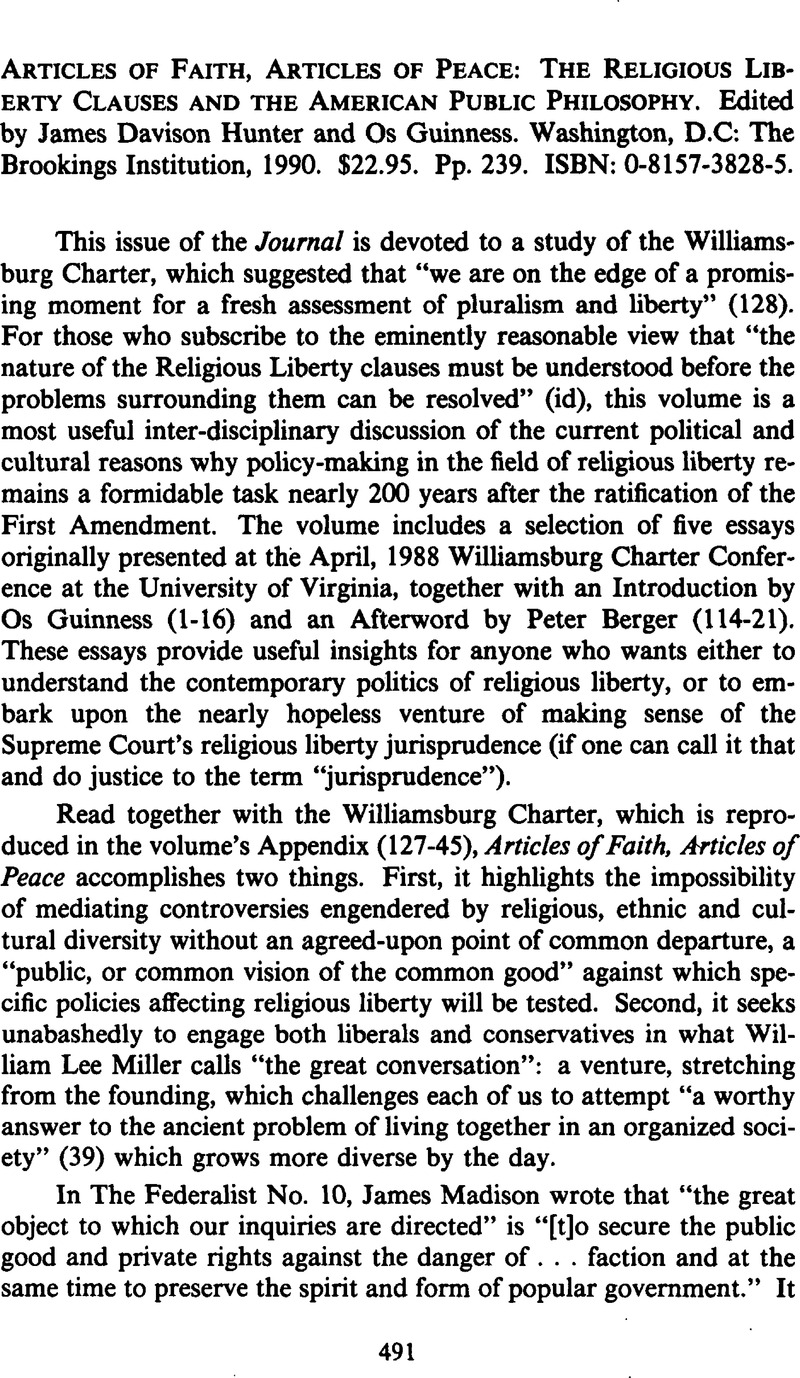No CrossRef data available.
Article contents
Articles of Faith, Articles of Peace: The Religious Liberty Clauses and the American Public Philosophy. Edited by James Davison Hunter and Os Guinness. Washington, D.C: The Brookings Institution, 1990. $22.95. Pp. 239. ISBN: 0-8157-3828-5.
Published online by Cambridge University Press: 24 April 2015
Abstract

- Type
- VII. Review Essays and Book Reviews
- Information
- Copyright
- Copyright © Center for the Study of Law and Religion at Emory University 1990
References
1. Cramton, Roger, The Ordinary Religion of the Law School Classroom, 29 J Legal Ed 247, 247–48 (1978)Google Scholar. Though Dean Cramton was speaking of the unarticulated value systems which influence American legal education, the criticism is equally applicable to cases involving religious liberty.
2. Id.
3. See, e.g., Bd of Education of Westside Community Schools v Mergens, 110 S Ct 2356, 2391 (1990) (Stevens dissenting) (religion is a divisive force incompatible with the mission of the public schools); Aguilar v Felton, 473 US 402 (1985) (teachers in religiously affiliated schools are “ideological” whereas their counterparts in public and non-religious private schools apparently are not). Dean Gaffney has argued that the Court should abandon its “political divisiveness” test in Establishment Clause cases. Gaffney, Edward McGlynn, Political Divisiveness Along Religious Lines: The Entanglement of the Court in Sloppy History and Bad Public Policy, 24 St Louis Univ L J 205 (1980)Google Scholar.
4. See, e.g., Wallace v Jaffree, 472 US 38 (1985), aff'g Smith v Board of School Commissioners of Mobile County, 827 F 2d 822 (11th Cir 1988), rev'g 655 F Supp 939 (SD Ala 1987). Compare Cramton, at 248 (cited in note 1).
5. See, e.g., County of Allegheny v ACLU, 109 S Ct 3086 (1989). Compare Michael H and Victoria D v Gerald D, 109 S Ct 2333 (1989); Bowers v Hardwick, 478 US 186, 210 (1986) (Blackmun dissenting).
6. See, e.g., Employment Div v Smith, 110 S Ct 1595 (1990), rev'g Smith v Employment Div, 307 Or 68, 763 P 2d 146 (1988), on remand from, 485 US 660 (1988) (standard of review in Free Exercise cases); County of Allegheny v ACLU, 109 S Ct 3086, 3111 (1989) (object of First Amendment is to protect “secular liberty”). Compare Patterson v McLean Credit Union, 109 S Ct 2363 (1989) (preserving the rule of Runyon v McCrary, 427 US 160 (1976)); Johnson v Transportation Agency, Santa Clara County, 107 S Ct 1142, 1458 (Stevens concurring) (noting change in original construction of the Civil Rights Act of 1964).
7. Compare, e.g., Akron v Akron Center for Reproductive Health, 462 US 416, 419-20 & n 1 (1983) with Webster v Reproductive Health Services, 109 S Ct 3040 (1989).
8. Compare County of Allegheny v ACLU, 109 S Ct 3086 (1989) and Texas Monthly v Bullock, 109 S Ct 890 (1989) with Employment Div v Smith, 110 S Ct 1595 (1990) and Hernandez v Commissioner of Internal Revenue, 109 S Ct 2136 (1989).
9. Martin v Wilks, 109 S Ct 2180 (1989) (5-4 decision); Lorance v AT & T Technologies, Inc, 109 S Ct 2261 (1989) (6-3 decision); Patterson v McLean Credit Union, 109 S Ct 2363 (1989) (6-3 on the disputed issues); Wards Cove Packing Co, Inc vAtonio, 109 S Ct 2115 (1989) (5-4 decision); City of Richmond v JA Croson Co, Inc, 109 S Ct 706 (1989) (5-4 decision).
10. Webster (cited in note 7).
11. But see Watz v Tax Comm'n, 397 US 664, 687-90 (1970) (Brennan concurring) (secular purpose includes only activities that promote public welfare or “contribute to the pluralism of American society”).
12. Editor's Note: See Hunter, James Davison, The Williamsburg Charter Survey: Methodology and Findings, 257 aboveGoogle Scholar.
13. Cantwell v Connecticut, 310 US 296 (1940).
14. Everson v Bd of Education, 330 US 1 (1947).
15. See, e.g., Mergens, 110 S Ct at 2381-82 (cited in note 3) (Marshall concurring) (dispute over whether or not a majority requires a showing of “coercion” before a violation of the Establishment Clause has been demonstrated).
16. Everson, 330 US at 18 (cited in note 14).
17. Compare William Lee Miller's discussion of the French intellectuals (28-29).


